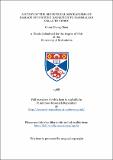A study of the biophysical mechanisms of damage by ionizing radiation to mammalian cells 'in vitro'
Abstract
An extensive survey made of published survival data of damage by ionizing radiation to mammalian cells in vitro has led to the new conclusion that the damage is determined by the specific ionization or the mean free path between ionizing events along the charged particle tracks. The optimum damage is observed when the mean free path is equivalent to the DNA double strand spacing of 1.8 nm. Therefore, the biological mechanism of ionizing radiation to mammalian cells in vitro is intra track dominant. A 100 keV electron accelerator has been constructed and commissioned to produce a broad beam irradiation field of greater than 1 cm diameter. The fluence rate may be adjusted from 10<super> 8</super> cm-2-sec-1 downwards to enable further development as a chronic irradiation facility. Another new feature of the accelerator is that it incorporates a differential vacuum system which permits irradiation of the monolayer cell cultures to be carried out in normal pressure. Experiments of irradiation to Chinese hamster cells, by 241Am alpha particles at low fluence rate, have supplied satisfactory data for testing a new DNA-rupture model which is under development. For V79 cells irradiated at a low fluence rate of 10<super>5 </super> cm-2-min-1, when survival data were fitted into the model, new biophysical parameters were extracted and a proposal was made that the repair phenomenon of cellular survival at very low doses is determined by three time factors; the irradiation time, the damage fixation time and the repair time. The values obtained were 3-4 hours for the mean repair time, and more than 10 hours for the damage to be considered permanent. Details of the monolayer cell culture technique developed and used in the present experiments are described. Consideration has been given to the significance of the results obtained from the study in radiation protection and in radiotherapy. In future studies it is recommended that more attention should be paid to measure the ionization events of the radiation studied. Towards the objective of producing a unified dosimeter, more studies are needed to correlate the results for electrons and neutrons for which less data are available. In this thesis the background and the basic theories are introduced in Chapters I and II. Experimental details are described in Chapter III on physical aspects and Chapter IV on biological aspects. Finally the results and discussion are presented in Chapter V.
Type
Thesis, PhD Doctor of Philosophy
Collections
Items in the St Andrews Research Repository are protected by copyright, with all rights reserved, unless otherwise indicated.

